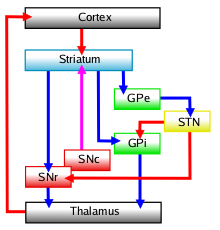External globus pallidus
(Redirected from Globus pallidus externus)
External Globus Pallidus
The external globus pallidus (GPe) is a subregion of the globus pallidus, which is part of the basal ganglia in the brain. The basal ganglia are a group of nuclei in the brain associated with a variety of functions, including the regulation of voluntary motor movements, procedural learning, routine behaviors or "habits", eye movements, cognition, and emotion.
Anatomy[edit | edit source]
The external globus pallidus is located lateral to the internal globus pallidus (GPi) and medial to the putamen. It is part of the lentiform nucleus, which also includes the putamen. The GPe is separated from the GPi by the medial medullary lamina, a thin layer of white matter.
Function[edit | edit source]
The external globus pallidus plays a crucial role in the indirect pathway of the basal ganglia circuitry. It receives inhibitory input from the striatum and sends inhibitory output to the subthalamic nucleus (STN). This pathway is essential for the regulation of movement and the suppression of involuntary movements.
Pathways[edit | edit source]
The GPe is involved in several important neural pathways:
- **Indirect Pathway**: In this pathway, the GPe receives input from the striatum and projects to the STN. The STN then projects to the GPi and the substantia nigra pars reticulata (SNr), which in turn project to the thalamus and then to the cerebral cortex.
- **Projections to the Subthalamic Nucleus**: The GPe sends inhibitory signals to the STN, which is a critical component of the indirect pathway. This interaction helps modulate the activity of the GPi and SNr.
Clinical Significance[edit | edit source]
Dysfunction in the external globus pallidus is associated with several neurological disorders, including Parkinson's disease, Huntington's disease, and dystonia. In Parkinson's disease, the loss of dopaminergic neurons in the substantia nigra pars compacta leads to increased activity in the GPe, which disrupts the normal balance of the basal ganglia circuitry and results in motor symptoms such as tremors, rigidity, and bradykinesia.
Research[edit | edit source]
Ongoing research is focused on understanding the precise role of the GPe in the basal ganglia circuitry and its involvement in various neurological disorders. Advances in neuroimaging and electrophysiological techniques are providing new insights into the function and dysfunction of the GPe.
See Also[edit | edit source]
- Basal ganglia
- Globus pallidus
- Internal globus pallidus
- Subthalamic nucleus
- Parkinson's disease
- Huntington's disease
- Dystonia
References[edit | edit source]
External Links[edit | edit source]
Translate: - East Asian
中文,
日本,
한국어,
South Asian
हिन्दी,
தமிழ்,
తెలుగు,
Urdu,
ಕನ್ನಡ,
Southeast Asian
Indonesian,
Vietnamese,
Thai,
မြန်မာဘာသာ,
বাংলা
European
español,
Deutsch,
français,
Greek,
português do Brasil,
polski,
română,
русский,
Nederlands,
norsk,
svenska,
suomi,
Italian
Middle Eastern & African
عربى,
Turkish,
Persian,
Hebrew,
Afrikaans,
isiZulu,
Kiswahili,
Other
Bulgarian,
Hungarian,
Czech,
Swedish,
മലയാളം,
मराठी,
ਪੰਜਾਬੀ,
ગુજરાતી,
Portuguese,
Ukrainian
Navigation: Wellness - Encyclopedia - Health topics - Disease Index - Drugs - World Directory - Gray's Anatomy - Keto diet - Recipes
Search WikiMD
Ad.Tired of being Overweight? Try W8MD's physician weight loss program.
Semaglutide (Ozempic / Wegovy and Tirzepatide (Mounjaro / Zepbound) available.
Advertise on WikiMD
WikiMD is not a substitute for professional medical advice. See full disclaimer.
Credits:Most images are courtesy of Wikimedia commons, and templates Wikipedia, licensed under CC BY SA or similar.Contributors: Prab R. Tumpati, MD


